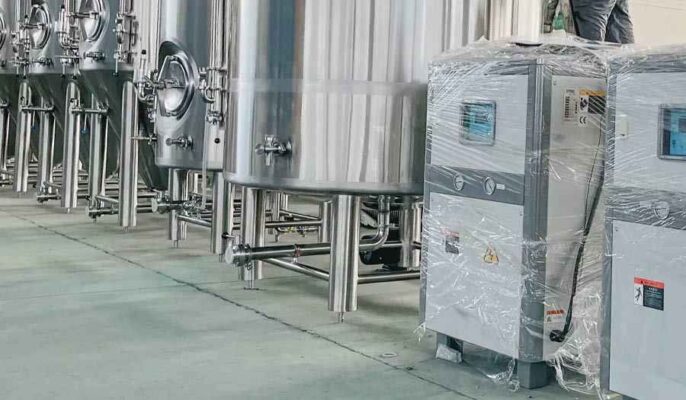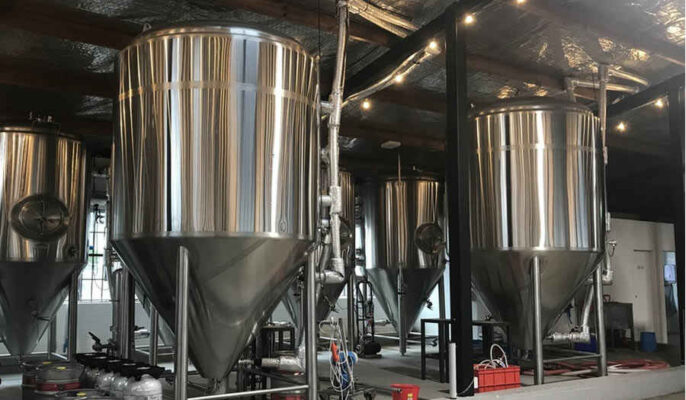Overview of Industrial Brewery Equipment
Industrial brewery equipment encompasses the various systems and machinery used to produce beer on a large commercial scale. Key equipment details:
- Made from stainless steel to maintain sanitary conditions and prevent corrosion.
- Designed for continuous high volume production, automation, and efficiency.
- Equipment choices determine batch sizes, production rate, degree of automation, beer styles produced etc.
- Main systems include brewhouse, fermentation and conditioning, filtration, packaging.
- Additional equipment like boilers, chillers, storage tanks, piping, conveyors, controls.
- Many options for level of automation from manual to fully automated plants.
- Selection driven by production goals, capital budget, existing infrastructure, and staffing capabilities.
Types of Industrial Brewing Equipment
| Function | Equipment Types |
|---|---|
| Milling | Roller mills, hammer mills |
| Mashing | Mash tuns, stirred kettles |
| Lautering | Lauter tuns, mash filters |
| Wort boiling | Brew kettles |
| Fermentation | Conical fermenters, yeast propagators |
| Maturation | Bright beer tanks, conditioning tanks |
| Filtration | Plate filters, centrifuges, precoat filters |
| Packaging | Bottling lines, canning lines, kegging lines |
Various equipment options suit different production scales, automation needs, and brewing methods.
Industrial Brewing Equipment Manufacturers
| Manufacturer | Description |
|---|---|
| Manufacturer 1 | Complete turnkey systems. Fully automated. |
| Manufacturer 2 | Custom fabrications. Specialty brewhouses. |
| Manufacturer 3 | Budget import equipment. Manual lines. |
| Manufacturer 4 | European equipment. Focus on sustainability. |
Many worldwide providers offer industrial brewing equipment ranging from modular manual systems to highly engineered fully integrated plants.
Key Specifications
| Parameter | Typical Values |
|---|---|
| Batch sizes | 3 bbl to 100+ bbl |
| Production rate | 10 bbl/hour to 1000+ bbl/hour |
| Material | Stainless steel grade 316L or better |
| Finish | Sanitary tri-clamp, interior polish < 0.5 Ra |
| Automation level | Manual, semi-auto, fully automated |
| Power | 480V 3-phase electrical |
| Water usage | 5-10 barrels of water per barrel of beer |
| Plant footprint | 3000 – 50000+ sqft ranges |
Specs depend heavily on production goals, capital budget, and expansion plans.

How to Select an Industrial Brewery Equipment Supplier
Key factors when choosing an industrial brewery equipment supplier:
- Technical expertise – Look for extensive engineering knowledge and experience designing and building brewing systems.
- Track record – Select a supplier with proven success installing systems for breweries of similar size and scale to yours.
- Quality – The supplier should use high grade stainless steel and precise fabrication for consistency and reliability.
- Project management – Strong project management ensures delivery on schedule and budget.
- Customization – Choose a supplier able to provide customized configurations tailored for your needs.
- Automation capabilities – Assess ability to provide automation level you require, from manual to cutting-edge.
- Service and support – Availability to provide continued tech support, maintenance, and service long-term.
- Operating costs – Consider capital cost against operating expenses of systems with different levels of automation.
Select an equipment supplier with expertise in industrial brewing with a track record of satisfied clients operating successful breweries.
Key Considerations When Designing an Industrial Brewery
- Analyze production volume goals, beer types/styles, seasonality, and growth projections. Size equipment appropriately.
- Layout equipment in a logical flow from raw materials to packaged products optimized for staff and material movement.
- Determine required utilities – electrical, water, steam, glycol, compressed air – for all equipment.
- Select automation level balancing production rate goals vs. available staff capability and budget.
- Accommodate future expansion. Leave space for additional tanks, new packaging lines.
- Provide walls, doors, airflow to separate areas with different sanitary requirements like packaging from fermentation.
- Design infrastructure for cleaning and sanitation like CIP systems, drain trenches, hot water supply.
- Meet any hazardous area requirements for electrical equipment and dust control with dust collection systems.
- Comply with all local building, electrical, fire, and other relevant codes. Secure necessary permits.
Work with professional engineers experienced in brewery design to optimize your facility for productivity, quality, and budget.
Equipment Installation Best Practices
Follow these best practices for installing industrial brewing equipment:
- Have qualified technicians perform installations – do not attempt DIY equipment rigging and setup.
- Use appropriate materials handling equipment – cranes, forklifts, rigging – to safely unload and position equipment.
- Check foundations are properly designed with required uprights, trenching, drainage.
- Make any needed facility mods ahead of delivery – enlarged doorways, removed walls, added electrical.
- Verify adequate utility supply hookups – electric, water, drains – at correct capacities.
- Allow technicians adequate access – remove any obstacles to rigging and fitting equipment in place.
- Check clearances between installed equipment for safe maintenance access and service.
- Inspect equipment for completeness, any shipping damage, loose fittings or fasteners.
- Have technicians verify equipment is leveled, aligned, securely mounted, and ready for connections.
Thorough planning and preparation of the facility in advance facilitates efficient installation by the suppliers’ technicians.
Controls and Automation
Industrial breweries utilize automation and control systems to:
- Monitor tanks, temperatures, flow rates, pressures, utility supply.
- Log data for statistical analysis and batch comparison.
- Interface equipment together – coordinate timings, sequences, material transfers.
- Integrate sensors for in-process measurement and inspection.
- Track batches, inventory, QA testing results and other records.
- Alarm operators of any out-of-spec process conditions or equipment issues.
- Automate repetitive manual tasks like material movement between vessels.
- Provide central dashboard views of the brewing process for monitoring and control.
Selecting the automation system capabilities depends on budget, staff capability, and the level of process control required. Start modestly at first.
Cleaning and Sanitation Systems
Maintaining sanitary conditions is critical in an industrial brewery. Key sanitation methods include:
- Clean-in-place (CIP) systems – spray balls, hoses, pumps deliver cleaning solutions to equipment interiors.
- Manual cleaning – disassemble, rinse, scrub equipment exteriors and parts.
- Cleaning chemicals – alkaline and acid cleaners to remove residue, sanitize surfaces.
- Ozone systems – gaseous ozone or ozonated water to sanitize and reduce chemical usage.
- Hot liquor – uses hot brewing water above 80°C for heat sanitization.
- Air purge steam condensate rinses to prevent residue drying and buildup.
- Dedicated cleaning staff responsible for developing and executing plans that follow brewery sanitary standard operating procedures (SSOPs).
Plan cleaning systems during facility design so all equipment is accessible and designed for ease of cleaning.
Maintenance Guide for Industrial Brewing Equipment
| Equipment | Maintenance Tasks | Frequency |
|---|---|---|
| Pumps | Inspect, lubricate, mechanical seal replacement | Monthly |
| Motors | Check alignment, lubricate bearings, clean exterior | Quarterly |
| Valves | Inspect, replace seals/gaskets | Annual |
| Tanks | Inspect interior surfaces, fittings, welds. Calibrate level sensors. | Annual |
| Hoses | Inspect for cracks, wear. Replace damaged hoses. | Monthly |
| Gaskets | Inspect condition. Replace compressed or worn gaskets. | Annual |
| Sensors | Calibrate temperature, pressure, flow sensors. | Quarterly per manufacturer |
| Conveyors | Lubricate bearings/chains. Inspect belt/chain wear. | Monthly |
| Automation | Test controls, alarms, network connectivity. Update software/firmware. | Ongoing |
Follow manufacturer recommendations for maintenance schedules. Log and document all maintenance activities.
Troubleshooting Common Industrial Brewery Issues
| Problem | Potential Causes | Solutions |
|---|---|---|
| Cloudy beer | Yeast health, premature yeast flocculation, storage temps, contamination | Adjust fermentation parameters, replace yeast, clean storage tanks, improve sanitation |
| Off-flavors | Infection, oxidation, lightstruck, aging hops | Improve sanitation, replace hops, use opaque packaging |
| Low attenuation | Underpitched yeast, poor yeast health, incomplete saccharification | Ensure proper pitch rates, oxygenate wort, verify mash conditions |
| Poor head retention | Old hops, low carbonation, dirty glassware, ingredients | Use fresh hops, adjust carbonation, improve cleaning, replace ingredients |
| Equipment fouling | Insufficient cleaning, outdated cleaning chemicals, water chemistry issues | Review cleaning procedures, assess water properties, replace cleaning chemicals |
Thorough root cause analysis using lab testing coupled with process reviews is key to addressing quality issues.
Pros and Cons of Different Levels of Brewery Automation
High Automation
Pros
- Increased consistency and reproducibility between batches
- Higher production rates and volumes
- Reduce labor requirements
- Tighter process control parameters
Cons
- High capital investment
- Still requires skilled staff to oversee automated systems
- Complex programming and integration
- Equipment costs more to maintain and service
Low/Manual Automation
Pros
- Lower equipment capital costs
- Simpler startup operation
- Flexibility in production schedule
- Staff gain firsthand brewing experience
Cons
- Inconsistent results dependent on staff skills
- Limited production capacity
- Labor intensive manual tasks
- Requires significant staff training time
- Difficult to scale up production

FAQs
Q: What size brewery is considered industrial scale?
A: Industrial breweries are typically over 15 bbl production capacity, designed for larger continuous batch production vs pilot or craft brewing systems.
Q: What material is brewing equipment made from?
A: Stainless steel grade 316L or better is standard. Select alloys like 304 avoid corrosion from cleaning chemicals and acidic solutions.
Q: How long does it take to design and build a new industrial brewery?
A: 6-18 months depending on the scale and customization involved. Time is required for planning, equipment fabrication and site preparation.
Q: What utilities does a brewery need?
A: Electrical power, steam, compressed air or gas, hot water, glycol or refrigeration, CO2, wastewater drainage, ventilation are typical requirements.
Q: How much space do industrial breweries require?
A: Needs vary dramatically based on production rate but roughly 3000-6000 sqft per 10,000 bbl/yr capacity for the brewhouse and fermentation. Warehousing, packaging areas are additional.
Q: How frequently does brewing equipment need maintenance?
A: Regular preventative maintenance on a weekly to quarterly basis for each equipment type is recommended, following manufacturers’ guidelines.
Q: Can brewing equipment be customized?
A: Yes, reputable industrial suppliers can provide highly customized one-off fabrications tailored to specific needs not satisfied by off-the-shelf models.
Q: How can industrial breweries reduce water usage?
A: Strategies like counterflow rinsing between vessels, recycling condensate, knock-out water, and other methods like ozone use instead of chemicals.




